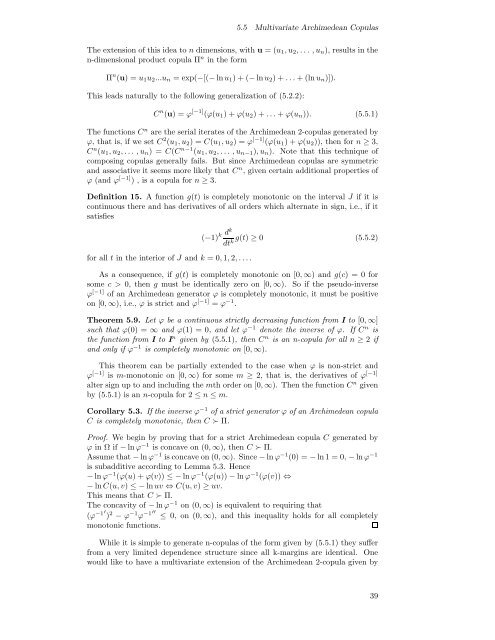Modelling Dependence with Copulas - IFOR
Modelling Dependence with Copulas - IFOR
Modelling Dependence with Copulas - IFOR
You also want an ePaper? Increase the reach of your titles
YUMPU automatically turns print PDFs into web optimized ePapers that Google loves.
5.5 Multivariate Archimedean <strong>Copulas</strong><br />
The extension of this idea to n dimensions, <strong>with</strong> u =(u 1 ,u 2 ,... ,u n ), results in the<br />
n-dimensional product copula Π n in the form<br />
Π n (u) =u 1 u 2 ...u n =exp(−[(− ln u 1 )+(− ln u 2 )+...+(lnu n )]).<br />
This leads naturally to the following generalization of (5.2.2):<br />
C n (u) =ϕ [−1] (ϕ(u 1 )+ϕ(u 2 )+...+ ϕ(u n )). (5.5.1)<br />
The functions C n are the serial iterates of the Archimedean 2-copulas generated by<br />
ϕ, that is, if we set C 2 (u 1 ,u 2 )=C(u 1 ,u 2 )=ϕ [−1] (ϕ(u 1 )+ϕ(u 2 )), then for n ≥ 3,<br />
C n (u 1 ,u 2 ,... ,u n )=C(C n−1 (u 1 ,u 2 ,... ,u n−1 ),u n ). Note that this technique of<br />
composing copulas generally fails. But since Archimedean copulas are symmetric<br />
and associative it seems more likely that C n , given certain additional properties of<br />
ϕ (and ϕ [−1] ) , is a copula for n ≥ 3.<br />
Definition 15. A function g(t) is completely monotonic on the interval J if it is<br />
continuous there and has derivatives of all orders which alternate in sign, i.e., if it<br />
satisfies<br />
(−1) k dk<br />
g(t) ≥ 0 (5.5.2)<br />
dtk for all t in the interior of J and k =0, 1, 2,....<br />
As a consequence, if g(t) is completely monotonic on [0, ∞) andg(c) =0for<br />
some c>0, then g must be identically zero on [0, ∞). So if the pseudo-inverse<br />
ϕ [−1] of an Archimedean generator ϕ is completely monotonic, it must be positive<br />
on [0, ∞), i.e., ϕ is strict and ϕ [−1] = ϕ −1 .<br />
Theorem 5.9. Let ϕ be a continuous strictly decreasing function from I to [0, ∞]<br />
such that ϕ(0) = ∞ and ϕ(1) = 0, andletϕ −1 denote the inverse of ϕ. If C n is<br />
the function from I to I n given by (5.5.1), thenC n is an n-copula for all n ≥ 2 if<br />
and only if ϕ −1 is completely monotonic on [0, ∞).<br />
This theorem can be partially extended to the case when ϕ is non-strict and<br />
ϕ [−1] is m-monotonic on [0, ∞) forsomem ≥ 2, that is, the derivatives of ϕ [−1]<br />
alter sign up to and including the mth order on [0, ∞). Then the function C n given<br />
by (5.5.1) is an n-copula for 2 ≤ n ≤ m.<br />
Corollary 5.3. If the inverse ϕ −1 of a strict generator ϕ of an Archimedean copula<br />
C is completely monotonic, then C ≻ Π.<br />
Proof. We begin by proving that for a strict Archimedean copula C generated by<br />
ϕ in Ω if − ln ϕ −1 is concave on (0, ∞), then C ≻ Π.<br />
Assume that − ln ϕ −1 is concave on (0, ∞). Since − ln ϕ −1 (0) = − ln 1 = 0, − ln ϕ −1<br />
is subadditive according to Lemma 5.3. Hence<br />
− ln ϕ −1 (ϕ(u)+ϕ(v)) ≤−ln ϕ −1 (ϕ(u)) − ln ϕ −1 (ϕ(v)) ⇔<br />
− ln C(u, v) ≤−ln uv ⇔ C(u, v) ≥ uv.<br />
This means that C ≻ Π.<br />
The concavity of − ln ϕ −1 on (0, ∞) is equivalent to requiring that<br />
(ϕ −1′ ) 2 − ϕ −1 ϕ −1′′ ≤ 0, on (0, ∞), and this inequality holds for all completely<br />
monotonic functions.<br />
While it is simple to generate n-copulas of the form given by (5.5.1) they suffer<br />
from a very limited dependence structure since all k-margins are identical. One<br />
would like to have a multivariate extension of the Archimedean 2-copula given by<br />
39
















